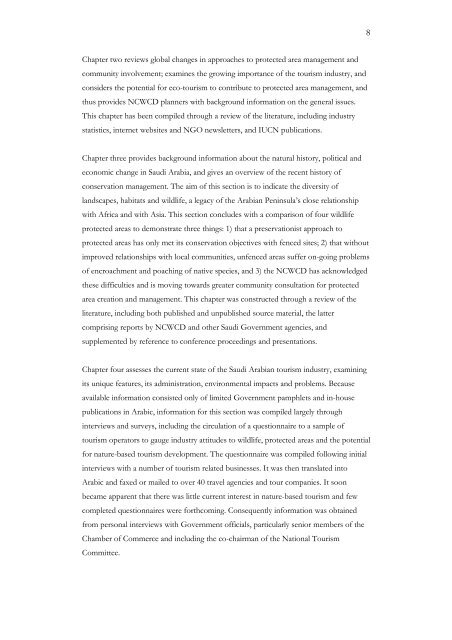The Unfenced Desert Towards a strategy for eco ... - Nwrc.gov.sa
The Unfenced Desert Towards a strategy for eco ... - Nwrc.gov.sa
The Unfenced Desert Towards a strategy for eco ... - Nwrc.gov.sa
You also want an ePaper? Increase the reach of your titles
YUMPU automatically turns print PDFs into web optimized ePapers that Google loves.
Chapter two reviews global changes in approaches to protected area management and<br />
community involvement; examines the growing importance of the tourism industry, and<br />
considers the potential <strong>for</strong> <strong>eco</strong>-tourism to contribute to protected area management, and<br />
thus provides NCWCD planners with background in<strong>for</strong>mation on the general issues.<br />
This chapter has been compiled through a review of the literature, including industry<br />
statistics, internet websites and NGO newsletters, and IUCN publications.<br />
Chapter three provides background in<strong>for</strong>mation about the natural history, political and<br />
<strong>eco</strong>nomic change in Saudi Arabia, and gives an overview of the recent history of<br />
conservation management. <strong>The</strong> aim of this section is to indicate the diversity of<br />
landscapes, habitats and wildlife, a legacy of the Arabian Peninsula’s close relationship<br />
with Africa and with Asia. This section concludes with a comparison of four wildlife<br />
protected areas to demonstrate three things: 1) that a preservationist approach to<br />
protected areas has only met its conservation objectives with fenced sites; 2) that without<br />
improved relationships with local communities, unfenced areas suffer on-going problems<br />
of encroachment and poaching of native species, and 3) the NCWCD has acknowledged<br />
these difficulties and is moving towards greater community consultation <strong>for</strong> protected<br />
area creation and management. This chapter was constructed through a review of the<br />
literature, including both published and unpublished source material, the latter<br />
comprising reports by NCWCD and other Saudi Government agencies, and<br />
supplemented by reference to conference proceedings and presentations.<br />
Chapter four assesses the current state of the Saudi Arabian tourism industry, examining<br />
its unique features, its administration, environmental impacts and problems. Because<br />
available in<strong>for</strong>mation consisted only of limited Government pamphlets and in-house<br />
publications in Arabic, in<strong>for</strong>mation <strong>for</strong> this section was compiled largely through<br />
interviews and surveys, including the circulation of a questionnaire to a <strong>sa</strong>mple of<br />
tourism operators to gauge industry attitudes to wildlife, protected areas and the potential<br />
<strong>for</strong> nature-based tourism development. <strong>The</strong> questionnaire was compiled following initial<br />
interviews with a number of tourism related businesses. It was then translated into<br />
Arabic and faxed or mailed to over 40 travel agencies and tour companies. It soon<br />
became apparent that there was little current interest in nature-based tourism and few<br />
completed questionnaires were <strong>for</strong>thcoming. Consequently in<strong>for</strong>mation was obtained<br />
from personal interviews with Government officials, particularly senior members of the<br />
Chamber of Commerce and including the co-chairman of the National Tourism<br />
Committee.<br />
8

















